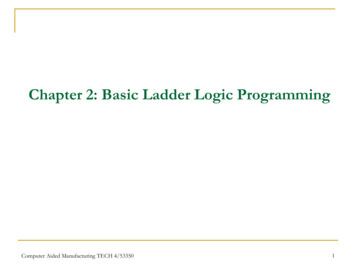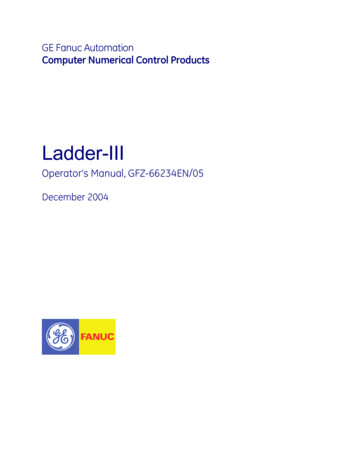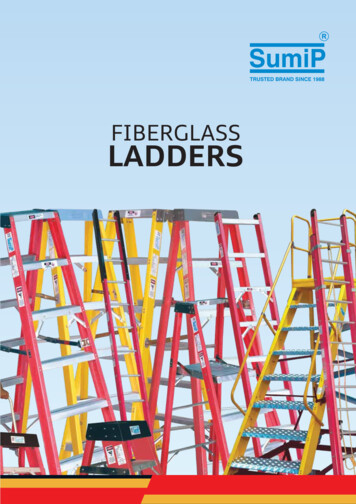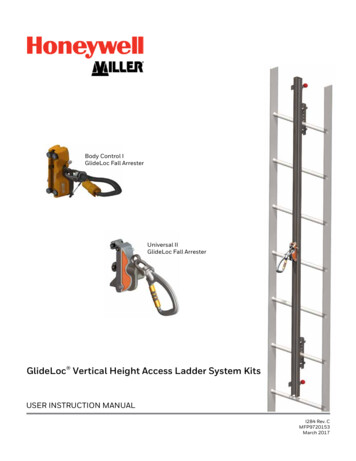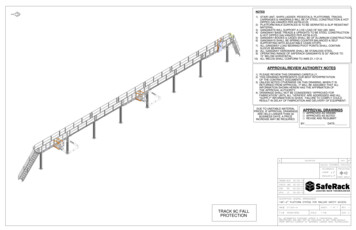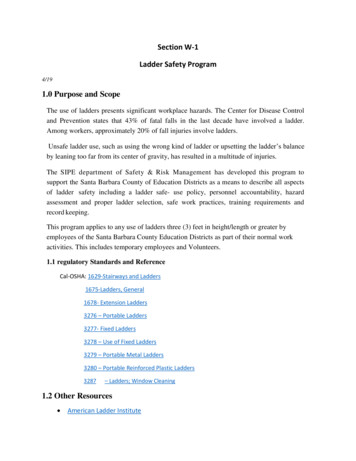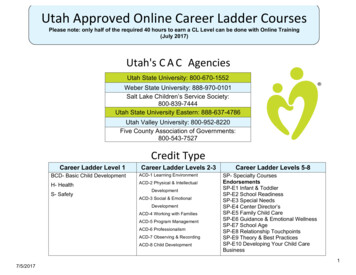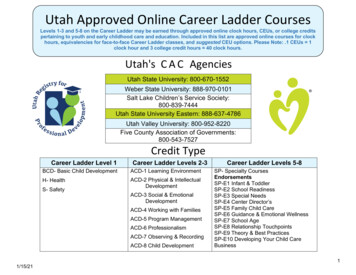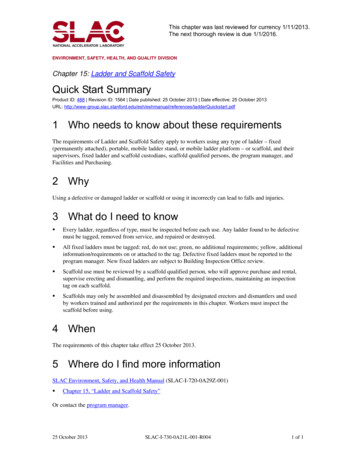
Transcription
This chapter was last reviewed for currency 1/11/2013.The next thorough review is due 1/1/2016.ENVIRONMENT, SAFETY, HEALTH, AND QUALITY DIVISIONChapter 15: Ladder and Scaffold SafetyQuick Start SummaryProduct ID: 488 Revision ID: 1564 Date published: 25 October 2013 Date effective: 25 October 2013URL: eferences/ladderQuickstart.pdf1 Who needs to know about these requirementsThe requirements of Ladder and Scaffold Safety apply to workers using any type of ladder – fixed(permanently attached), portable, mobile ladder stand, or mobile ladder platform – or scaffold, and theirsupervisors, fixed ladder and scaffold custodians, scaffold qualified persons, the program manager, andFacilities and Purchasing.2 WhyUsing a defective or damaged ladder or scaffold or using it incorrectly can lead to falls and injuries.3 What do I need to know Every ladder, regardless of type, must be inspected before each use. Any ladder found to be defectivemust be tagged, removed from service, and repaired or destroyed. All fixed ladders must be tagged: red, do not use; green, no additional requirements; yellow, additionalinformation/requirements on or attached to the tag. Defective fixed ladders must be reported to theprogram manager. New fixed ladders are subject to Building Inspection Office review. Scaffold use must be reviewed by a scaffold qualified person, who will approve purchase and rental,supervise erecting and dismantling, and perform the required inspections, maintaining an inspectiontag on each scaffold. Scaffolds may only be assembled and disassembled by designated erectors and dismantlers and usedby workers trained and authorized per the requirements in this chapter. Workers must inspect thescaffold before using.4 WhenThe requirements of this chapter take effect 25 October 2013.5 Where do I find more informationSLAC Environment, Safety, and Health Manual (SLAC-I-720-0A29Z-001) Chapter 15, “Ladder and Scaffold Safety”Or contact the program manager.25 October 2013SLAC-I-730-0A21L-001-R0041 of 1
ENVIRONMENT, SAFETY, HEALTH, AND QUALITY DIVISIONChapter 15Ladder and Scaffold SafetyProduct ID: 10 Revision ID: 1560 Date published: 25 October 2013 Date effective: 25 October 2013URL: dfs/ESHch15.pdf1 PurposeThe purpose of this program is to ensure the safe use of ladders and scaffolds. The program coversselecting, procuring, erecting, dismantling, inspecting, and using ladders and scaffolds. It applies toworkers, supervisors, fixed ladder and scaffold custodians, scaffold qualified persons, the programmanager, and Facilities and Purchasing.2 Roles and ResponsibilitiesFunctional roles and general responsibilities for each are listed below. More detailed responsibilities andwhen they apply are provided in the requirements documents.The roles may be performed by one or more individuals and one individual may play more than one role,depending on the structure of the organizations involved, and responsibilities may be delegated.2.1 Worker Completes required training before first use Follows safe use practicesAs a ladder user Verifies an inspection tag is attached to a fixed ladder. Green tagged ladders may be used withoutadditional requirements; yellow tagged ladders will have additional information/requirements on orattached to the tag; red tagged ladders are not to be used. Performs pre-use inspection every time he or she uses a ladder and reports unsafe conditions to laddercustodian or supervisor Reports fixed ladders that fail the pre-use inspection to the ladder custodianAs a scaffold user Verifies an inspection tag is attached to the scaffold with a scaffold qualified person’s name,signature, and date before using a scaffold Performs pre-use inspection before accessing the scaffold and reports unsafe conditions to thequalified person listed on the inspection tag, custodian, or supervisor (confirming no change inconditions since last inspection)25 October 2013SLAC-I-720-0A29Z-001-R023.71 of 6
SLAC National Accelerator LaboratoryEnvironment, Safety, Health, and Quality DivisionChapter 15: Ladder and Scaffold Safety2.2 Supervisor Ensures that workers perform pre-use inspections and follow proper safe use practices Contacts scaffold qualified person to evaluate the need for scaffolding Ensures only ladders that meet applicable regulations and standards are authorized for purchase Ensures scaffolds are reviewed by a scaffold qualified person before they are authorized for purchase2.3 Fixed Ladder Custodian Is a building, facility, or area manager or person designated by line management Notifies the ladder and scaffold safety program manager when a ladder fails the required pre-useinspection Ensures fixed ladders are properly tagged (red, green, or yellow) and any ladder with specialrequirements (tagged yellow) has the requirements documented either on or attached to the tag2.4 Scaffold Custodian Ensures scaffolding is properly stored Ensures scaffold is properly maintained (in accordance with manufacturer’s recommendations andscaffold qualified person instructions)2.5 Scaffold Qualified Person Reviews scaffolding purchase requisitions and rental contracts before they are approved to ensurecompliance with SLAC requirements Reviews work plans for work performed at heights to help evaluate if scaffolding is needed Supervises scaffolding erection and dismantling Ensures correct, color-coded inspection tag is in place near the access point and is kept current2.6 Scaffold Erector / Dismantler Is trained and designated Erects and dismantles scaffolds according to scaffold qualified person instructions2.7 Facilities Maintains and repairs fixed ladders Responds to service requests for scaffolds2.8 Purchasing Ensures purchases or rentals of scaffolds are reviewed by a scaffold qualified person25 October 2013SLAC-I-720-0A29Z-001-R023.72 of 6
SLAC National Accelerator LaboratoryEnvironment, Safety, Health, and Quality DivisionChapter 15: Ladder and Scaffold Safety2.9 Program Manager Must be a scaffold qualified and fall protection competent person Develops program requirements and develops training Maintains list of scaffold qualified persons and scaffold erectors/dismantlers Maintains list of every fixed ladder and its status3 Procedures, Processes, and RequirementsThese documents list the core requirements for this program and describe how to implement them: Ladder and Scaffold Safety: Fixed Ladder Procedures (SLAC-I-730-0A21C-001). Describesprocurement, commissioning, inspection, and use of fixed ladders Ladder and Scaffold Safety: Portable Ladder Requirements (SLAC-I-730-0A21S-001). Describesprocurement, selection, inspection, and use of all portable ladder types (extension, step, straight, andmobile) Ladder and Scaffold Safety: Scaffold Erecting and Dismantling Procedure (SLAC-I-730-0A21C-027).Describes process for selecting, erecting, dismantling, and inspecting scaffolds Ladder and Scaffold Safety: Scaffold Purchasing Procedure (SLAC-I-730-0A21C-028). Describesprocess for renting and buying scaffolds Ladder and Scaffold Safety: Scaffold Use Procedure (SLAC-I-730-0A21C-029). Describes safe use ofscaffoldsThese documents provide useful guidance; their use is not mandatory: Ladder and Scaffold Safety: Using Portable Ladders Safely (SLAC-I-730-0A21T-013). Providesguidance on how to choose a ladder appropriate for the task and use the ladder safely Ladder and Scaffold Safety: Portable Ladder Pre-use Inspection Checklist (SLAC-I-730-0A21J-001).Checklist of common inspection items, can be used to report problems4 Training4.1 Ladder UserAny person who will use a ladder to reach an elevation greater than 48 inches is required to take thefollowing course before performing such work: ESH Course 293, Ladder Safety Training (ESH Course 293)Any person who will use a fixed ladder requiring fall protection must complete additional trainingrequirements specified in Chapter 45, “Fall Protection”. (Fall protection requirements are posted onladders.)25 October 2013SLAC-I-720-0A29Z-001-R023.73 of 6
SLAC National Accelerator LaboratoryEnvironment, Safety, Health, and Quality DivisionChapter 15: Ladder and Scaffold Safety4.2 Scaffold UserAny person who will access or perform work on scaffolds must complete ESH Course 164, Safe Use of Scaffolding Training (ESH Course 164) (retrain every 36 months) ESH Course 293, Ladder Safety Training (ESH Course 293)4.3 Scaffold Erector / DismantlerAny person who will erect or dismantle scaffolding must complete ESH Course 166, Scaffold Erector/Dismantler Training (ESH Course 166) (retrain every 36 months) ESH Course 293, Ladder Safety Training (ESH Course 293)4.4 Scaffold Qualified PersonThe scaffold qualified person must complete ESH Course 165, Scaffold Qualified Person Training (ESH Course 165) (retrain every 36 months) ESH Course 166, Scaffold Erector/Dismantler Training (ESH Course 166) (retrain every 36 months) ESH Course 293, Ladder Safety Training (ESH Course 293)5 DefinitionsCage/well. A cage is a guard that may be referred to as a cage or basket guard, which is an enclosure that isfastened to the side rails of the fixed ladder or to the structure to encircle the climbing space of the ladderfor the safety of the person who must climb the ladder. A well is a permanent complete enclosure around afixed ladder, which is attached to the walls of the well. Proper clearances for a well will give the personwho must climb the ladder the same protection as a cage.Custodian, fixed ladder. A person at SLAC, either a building, facility, or area manager or a persondesignated by such, responsible for meeting fixed ladder requirementsCustodian, scaffold. A person at SLAC who has been designated by line management and is responsible forthe scaffolding in his or her careLadder, fixed. A ladder permanently attached to a structure, building, or equipmentLadder, portable Ladder, extension. A non-self-supporting portable ladder adjustable in length. It consists of two ormore sections traveling in guides or brackets so arranged as to permit length adjustment. Its size isdesignated by the sum of the lengths of the sections measured along the side rails. Ladder, mobile. A movable, fixed height, self-supporting ladder consisting of wide flat treads in theform of steps which give access to a top step25 October 2013SLAC-I-720-0A29Z-001-R023.74 of 6
SLAC National Accelerator LaboratoryEnvironment, Safety, Health, and Quality DivisionChapter 15: Ladder and Scaffold Safety Ladder, step. A self-supporting portable ladder, non-adjustable in length, having flat steps and a hingedback. Its size is designated by the overall length of the ladder measured along the front edge of the siderails. Ladder, straight (fixed-length). A non-self-supporting portable ladder that is not adjustable in lengthPerson, qualified. A person designated by the employer who by reason of training, experience orinstruction has demonstrated the ability to safely perform all assigned duties and, when required, isproperly licensed in accordance with federal, state, or local laws and regulationScaffold, system. A scaffold consisting of posts with fixed connection points that accept runners, bearers,and diagonals that can be interconnected at predetermined levelsScaffold, tube and coupler. An assembly consisting of tubing which serves as posts, bearers, braces, ties,and runners, a base supporting the posts, and uprights, and serves to join the various members, usually usedin fixed locations6 References6.1 External RequirementsThe following are the external requirements that apply to this program: Title 8, California Code of Regulations, “Industrial Relations”, Division 1, “Department of IndustrialRelations”, Chapter 4, “Division of Industrial Safety”, Subchapter 4, “Construction Safety Orders”,Article 25, “Ladders”–Section 1675, “General” (8 CCR 1675)–Section 1676, “Job-Made Ladders” (8 CCR 1676)Title 8, California Code of Regulations, “Industrial Relations”, Division 1, “Department of IndustrialRelations”, Chapter 4, “Division of Industrial Safety”, Subchapter 7, “General Industry Safety Orders”,Group 1, “General Physical Conditions and Structures Orders”, Article 4, “Access, Work Space, andWork Areas”–Section 3276, “Portable Ladders” (8 CCR 3276)–Section 3277, “Fixed Ladders” (8 CCR 3277)–Section 3278, “Use of Fixed Ladders” (8 CCR 3278)Title 8, California Code of Regulations, “Industrial Relations”, Division 1, “Department of IndustrialRelations”, Chapter 4, “Division of Industrial Safety”, Subchapter 7, “General Industry Safety Orders”,Group 4, “General Mobile Equipment and Auxiliaries”, Article 23, “Mobile Ladder Stands andScaffolds (Towers)”– Section 3627, “Mobile Ladder Stands” (8 CCR 3627)Title 8, California Code of Regulations, “Industrial Relations”, Division 1, “Department of IndustrialRelations”, Chapter 4, “Division of Industrial Safety”, Subchapter 4, “Construction Safety Orders”,–Article 21, “Scaffolds: General Requirements”, Section 1637, “General Requirements” (8 CCR1637)25 October 2013SLAC-I-720-0A29Z-001-R023.75 of 6
SLAC National Accelerator LaboratoryEnvironment, Safety, Health, and Quality DivisionChapter 15: Ladder and Scaffold Safety–Article 22, “Scaffolds – Various Types” (8 CCR Subchapter 4, Article 22)–Article 23, “Suspended Scaffolds”, Section 1658, “Suspended Scaffolds – General” (8 CCR 1658)The following industry-accepted standards: American National Standards Institute (ANSI) Accredited Standards Committee (ASC) A14.1-2007,“Wood Safety Requirements” (ANSI ASC A14.1-2007) ANSI ASC A14.2-2007, “Portable Metal - Safety Requirements” (ANSI ASC A14.2-2007) ANSI ASC A14.3-2008, “Fixed – Safety Requirements” (ANSI ASC A14.3-2008) ANSI ASC A14.5-2007, “Portable Reinforced Plastic – Safety Requirements” (ANSI ASC A14.52007) ANSI ASC A14.7-2011, “Mobile Ladder Stands and Mobile Ladder Stand Platforms” (ANSI ASCA14.7-2011) American National Stan
25 October 2013 SLAC-I-720-0A29Z-001-R023.7 3 of 6 . SLAC National Accelerator Laboratory Environment, Safety, Health, and Quality Division Chapter 15: Ladder and Scaffold Safety . 4.2 Scaffold User Any person who will access or perform work on scaffolds must complete ESH Course 164, Safe Use of Scaffolding Training (ESH Course 164) (retrain every 36 months) ESH Course 293,

